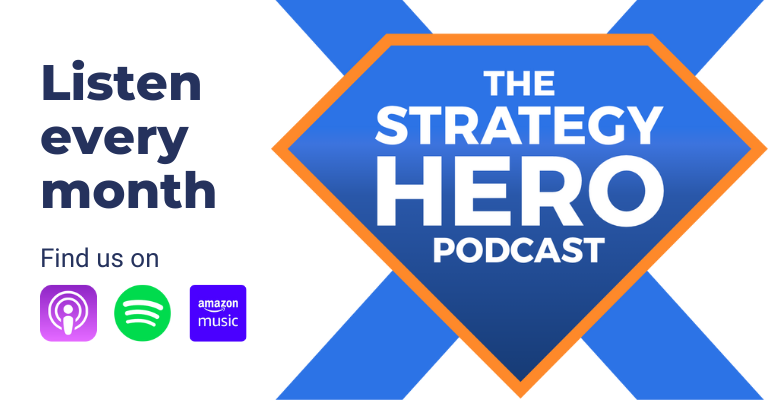What does it really take to get stuff done? That's a real challenge that few people in strategy execution can overcome, but not in this episode. Here's what I learned from season two, episode six of Strategy Hero with Garvan Callan.
One of the consistent challenges of strategy is its execution. For whatever reason, so few have found a way to lead and execute their business strategy.
Garvan Callan of OneZero1 puts practicality and action at the center of his consulting engagements, and that shows.
From hearing about the importance Garvan places on practicality and putting the human into strategy execution, to the concept of stradaptability, here's what I learned from my time with Garvan Callan.
It’s important to note that my opinions do not reflect those of i-nexus, Garvan Callan, and OneZero1.
Enjoy!
Why Garvan?
Before reaching out to Garvan, I had somewhat of an understanding of who he was through his book - Digital Business Strategy.
Anyone who has had the pleasure of knowing, being taught by, or working with Garvan knows that while humble, he's incredibly knowledgeable and practical.
I've always leaned towards the pragmatic. It's easy to talk about lofty concepts, but it's another thing to put those into action.
Our episode revolved around this: every business of every size is faced with the challenge of adapting or dying. Fixed strategies are passé. It's about being prepared to pivot on a dime and implement change that can see you thrive.
Meet stradaptability:
"Stradaptabiltiy is the practice of continual observation, experimentation, and maybe less experimentation, observation, calibration, and renewal."
The Power of Stradaptibility
We heard in the Charlie Sharman and Fredrik Fjellstedt episodes that a strategy is invaluable, but what's more valuable is being able to adapt.
Garvan echoed this with the stradaptibility.
We've heard Gartner and Forrester discuss this. But it's one thing for an advisory firm to advise; it's another for the business to implement it.
There's a reason Garvan speaks to the importance of agility. In tech alone, 90% of start-ups fail, and those are agile, nimble companies. Imagine the dangers that face a larger enterprise organization.
The truth is that strategy execution has changed.
Strategy for the digital age v digital strategy
Garvan made a crucial distinction that I believe every leader needs to hear:
"The successful organization is that which has a strategy for the digital age as opposed to a digital strategy for their current circumstances."
It reminds me of a conversation I once had with a colleague about digitalization and digitization—two entirely different concepts that people confuse.
The shift is significant. It's not about merely adding digital initiatives to existing strategies, but about fundamentally rethinking our approach to strategy in a digital world. Too much buzz and smoke and mirrors have been placed around the topic of digital transformation.
How we approach strategy in a digital world means considering how technologies and trends impact every aspect of our business, not just the obvious tech-related areas. A great example is what Jay McBain spoke about in episode one of season two:
"Every company is quickly having to become a tech company, regardless of their industry."
The importance of ambidexterity
Another concept that Garvan spoke to, tying into this idea of being agile in our approach to strategy execution, was organizational ambidexterity:
"For organizations to be sustainable... they had to have two speeds or two ways of thinking going on in the organization... they had to perpetually exploit the core, which is make what they had better... and that capacity had to be spent on exploration."
Sounds hard? That's because it is.
Having heard from members of our audience and from my own experience as a marketing leader, it's incredibly tough to switch your brain from today's reality to what's possible tomorrow.
Context shifting, which is what Garvan's talking about here, is tough.
It requires a certain cognitive dexterity from leaders and a willingness to operate at multiple speeds simultaneously.
Thankfully, Garvan's advice here offered leaders a framework to grapple with the imperative of innovation and protecting their core business, much like Pascal Dennis spoke to.
Putting the human into strategy's execution
Perhaps most importantly, Garvan emphasized the human element in strategy:
"It's not the code, it's not the technology. It's the coder. It's how we think about deploying it and using it and the pace at which we do the frames of reference and the data points that we explode to get to inform that."
This is a crucial reminder that strategy is fundamentally about people—how they think, work, and adapt.
In our rush towards new technologies and methodologies, we must not lose sight of the human element that drives innovation and success. From the Wright brothers to Turing, people drive change.
My takeaway: strategy execution is logic meets the customer
If strategy's execution takes innovation and execution, then you can only do that by applying logic to your surroundings, underpinned by what you understand of your customer.
In a world where buzzwords are akin to following the leader if you have a strong strategy and scenario plans at your core, you'll always have a way to address the most important questions of where we are, what we should do, and how we will get that done.
Garvan made that perfectly clear:
"I think you need to be customer obsessed. But I do believe that there is an additional lens, an accelerator... about this big ambition and this idea of being purposeful and this idea of thinking about competitive disadvantage or another way to frame that, which I like, is about constructive dissatisfaction."
That constructive dissatisfaction is what drives companies to keep delighting their customers, and isn't that why we're in this?
Garvan left us with what I feel was the perfect bow on the episode:
"I encourage you all to go on that journey of self reflection and observation, turn all the lights on, have a look and see what you see what you like and share it with the world, see what hasn't been solved yet, maybe think about a way to solve it and share that with the world as well."
In the end, strategy in the digital age is not about having all the answers, but about asking the right questions, being adaptable, and continually chasing improvement. Garvan offered a roadmap for this journey, challenging us to think differently about how we approach strategy in our rapidly changing world.
Thanks for being our sixth hero of the season, Garvan!
Listen to the episode
Garvan's episode was the sixth of season two of Strategy Hero.
You can click here to listen to Garvan's episode, search "Strategy Hero" wherever you find your favorite podcasts, or click the play button below.
About Strategy Hero
Published on the last Thursday of every month, the Strategy Hero podcast delves into the world of business strategy and transformation.
Each cast shines a spotlight on a Strategy Hero – inspirers, boundary pushers, and leaders of change from all walks of life – armed with practical advice on achieving your goals.
Episodes explore topics around operational excellence, Lean management, process improvement, change management, and much, much more. Available where all great podcasts live, listen on-demand today, and discover the Strategy Hero inside you.
About the host
James Milsom is Head of Marketing at i-nexus, but James is a storyteller. He’s the UK’s biggest Georgia Bulldogs fan (Go Dawgs!) and lives and breathes marketing.
The Strategy Hero podcast is his opportunity to bring some of his conversations with mentors, inspirers, and people anew to you every month.
He’s behind the content read and watched by people like you and lives to educate and help others.
If you’d like to learn more about him, connect with him on LinkedIn and subscribe to the Strategy Hero podcast today!



.jpg?width=352&name=KPIs%20(3).jpg)